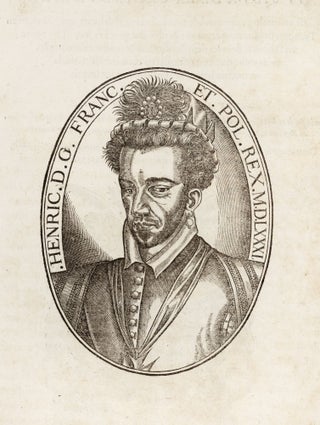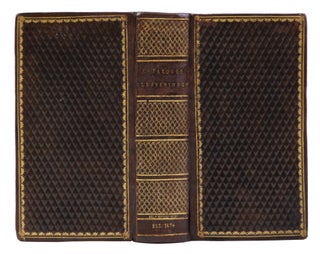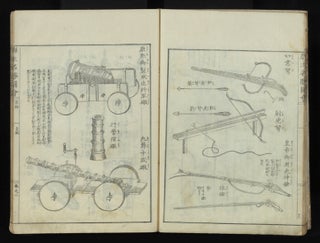The Emperor’s Procession to Nijo Castle
Two scrolls, the first finely illustrated, each entitled in manuscript on gold-paper labels on outer endpapers: “Gojorakunoki” [“Details of the Emperor’s Visit to [Nijo Castle in] Kyoto”].
Two scrolls (284 x 10,460 mm.; 10,950 mm., including front endpapers), speckled gold inner endpapers, outer endpapers covered in green silk with gold patterns. [Japan]: at the end of the second scroll (in trans.): “copied in 1830 by Chuwa Matsumura, having borrowed it from the family of Yahata” [?, our reading is uncertain, perhaps the family that lived in Awa Province, today’s Tokushima Prefecture].
These fine and handsome scrolls depict and describe the imperial procession and visit of Emperor Gomizunoo (1596–1680) to Nijo Castle in Kyoto in October 1626. Nijo Castle was the Kyoto residence of Shogun Tokugawa Iemitsu (1604–1651), who used the five-day imperial visit as a way to legitimize the newly established Tokugawa supremacy in the country. In order to further cement the primacy of the Tokugawa shogunate, Princess Masako, one of the daughters of the second shogun, Hidetada, had became the consort of the reigning Emperor, Gomizunoo, in 1620.
Preparations for the visit began in 1624. The procession itself was a lavish parade, which included an entourage of thousands, all elaborately (and meaningfully) dressed. During the Emperor’s stay at Nijo Castle, the shogun and his father, the retired former shogun Tokugawa Hidetada, treated the imperial family with great deference, presenting extravagant gifts and undertaking elaborate ceremonies over the five-day period. During the imperial visit, there were performances of Noh theater, waka (classical Japanese poetry) composition gatherings, traditional music performances, horseback riding events, and court kemari (a court ball game). This visit served as a statement of the wealth and stability of shogunal rule.
The first scroll is illustrated with a series of 20 fine paintings of scenes of the great procession. It begins with text, in a fine calligraphic hand, which explains all the components of the parade. The first scene depicts the Shoshidai (an important administrator) and his entourage of about 14 members. Wonderfully — and this is true throughout this scroll — there are manuscript labels identifying key participants and their governmental positions. Even those not pictured are identified.
There follows a series of 19 further scenes of groups within the procession, all identified with names, titles, and positions, including: 154 fiefdom lords (two are pictured with their entourages but all 154 are listed); the Roju Doi (Doi was an “Elder,” one of the highest-ranking government posts); two Metsuke (censors); Zoshiki (members of the military police); 22 Hakucho (servants to the Imperial Household, all dressed in white); the colorful and highly decorated imperial carriage, drawn by two oxen covered with ornate and brightly colored drapes with the chrysanthemum imperial crest, surrounded by many security men and attendants (including one servant carrying the Emperor’s shoes and a group of umbrella carriers); stable masters; the fiefdom lord of Owari General Tokugawa Yoshinao (the ninth son of Tokugawa Ieyasu) and his entourage, including a shoe carrier; two Karo (top-ranking samurai officials and advisors), Naruse and Takekoshi; Sendai Chunagon (a counselor of the second rank at the Imperial Court, with his entourage); Kaga Chunagon, with his own followers; Satsuma Chunagon, surrounded by his attendants; Echizen Saisho (a chancellor from Echizen), with his entourage; a number of fiefdom lords; and finally, at the of the procession, a large group of umbrella carriers.
We note that a number of the participants in the procession are not pictured in this scroll but are listed with names, titles, and positions. We believe this is unique and valuable information.
At the end of this scroll, we find the pen name “Chi Yoshizumi,” who states he copied this scroll, with his seal.
The second scroll contains all text, written in the same fine hand, describing the events during the actual five-day visit to Nijo Castle. The text begins with accounts of uta-awase (waka poetry contests); musical performances (with a list of the pieces performed, participants, and the schools they represented); seating arrangements during the evening uta-awase; many examples of waka poetry, including the Emperor’s own contributions, with 62 creators’ names and titles, arranged by rank; and Noh performances, with nine plays listed along with the performers’ names.
There is a list of gifts from the shogun, his wife, and his father for the Emperor, his wife Masako (the daughter of the retired shogun Hidetada), their children, and his mother. They include sacks of gold and silver, horses, daggers made of precious metals, 200 kimono, incense woods, deer musk, scrolls, dyes, bolts of silk from China, a gold incense burner, ornate candelabras, tea ceremony tools, silver vases, calligraphy tools and desks, books, honey, cash, pigments for makeup, white silk ready to be dyed, lacquerware, etc.
There is another list of gifts to members of the Emperor’s court and their wives, heads of 13 famous Buddhist temples, various dignitaries, ladies-in-waiting, etc. The names and positions of the recipients are given.
In fine condition, preserved in an old wooden box. Minor marginal worming towards the end of the second scroll.
Price: $8,500.00
Item ID: 8649

![Item ID: 8649 Two scrolls, the first finely illustrated, each entitled in manuscript on gold-paper labels on outer endpapers: “Gojorakunoki” [“Details of the Emperor’s Visit to [Nijo Castle in] Kyoto”]. EMPEROR GOMIZUNOO’S VISIT TO NIJO CASTLE.](https://jonathanahill.cdn.bibliopolis.com/pictures/8649.jpg?width=768&height=1000&fit=bounds&auto=webp&v=1672242624)
![Two scrolls, the first finely illustrated, each entitled in manuscript on gold-paper labels on outer endpapers: “Gojorakunoki” [“Details of the Emperor’s Visit to [Nijo Castle in] Kyoto”].](https://jonathanahill.cdn.bibliopolis.com/pictures/8649_2.jpg?width=320&height=427&fit=bounds&auto=webp&v=1672242624)
![Two scrolls, the first finely illustrated, each entitled in manuscript on gold-paper labels on outer endpapers: “Gojorakunoki” [“Details of the Emperor’s Visit to [Nijo Castle in] Kyoto”].](https://jonathanahill.cdn.bibliopolis.com/pictures/8649_3.jpg?width=320&height=427&fit=bounds&auto=webp&v=1672242624)
![Two scrolls, the first finely illustrated, each entitled in manuscript on gold-paper labels on outer endpapers: “Gojorakunoki” [“Details of the Emperor’s Visit to [Nijo Castle in] Kyoto”].](https://jonathanahill.cdn.bibliopolis.com/pictures/8649_4.jpg?width=320&height=427&fit=bounds&auto=webp&v=1672242624)
![Two scrolls, the first finely illustrated, each entitled in manuscript on gold-paper labels on outer endpapers: “Gojorakunoki” [“Details of the Emperor’s Visit to [Nijo Castle in] Kyoto”].](https://jonathanahill.cdn.bibliopolis.com/pictures/8649_5.jpg?width=320&height=427&fit=bounds&auto=webp&v=1672242624)
![Two scrolls, the first finely illustrated, each entitled in manuscript on gold-paper labels on outer endpapers: “Gojorakunoki” [“Details of the Emperor’s Visit to [Nijo Castle in] Kyoto”].](https://jonathanahill.cdn.bibliopolis.com/pictures/8649_6.jpg?width=320&height=427&fit=bounds&auto=webp&v=1672242624)



![Seikotsu shinsho 整骨新書 [New Book on Osteology], complete with atlas. Bunken 各務文獻 KAGAMI.](https://jonathanahill.cdn.bibliopolis.com/pictures/8981.jpg?width=320&height=427&fit=bounds&auto=webp&v=1686302648)